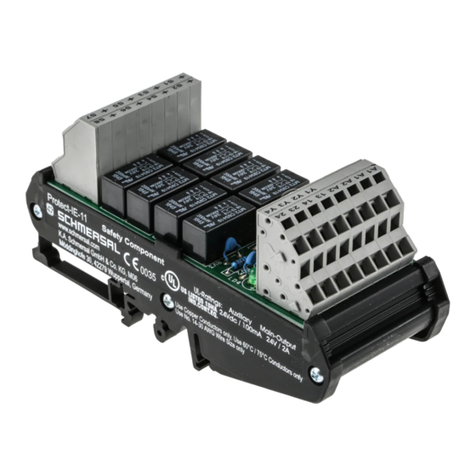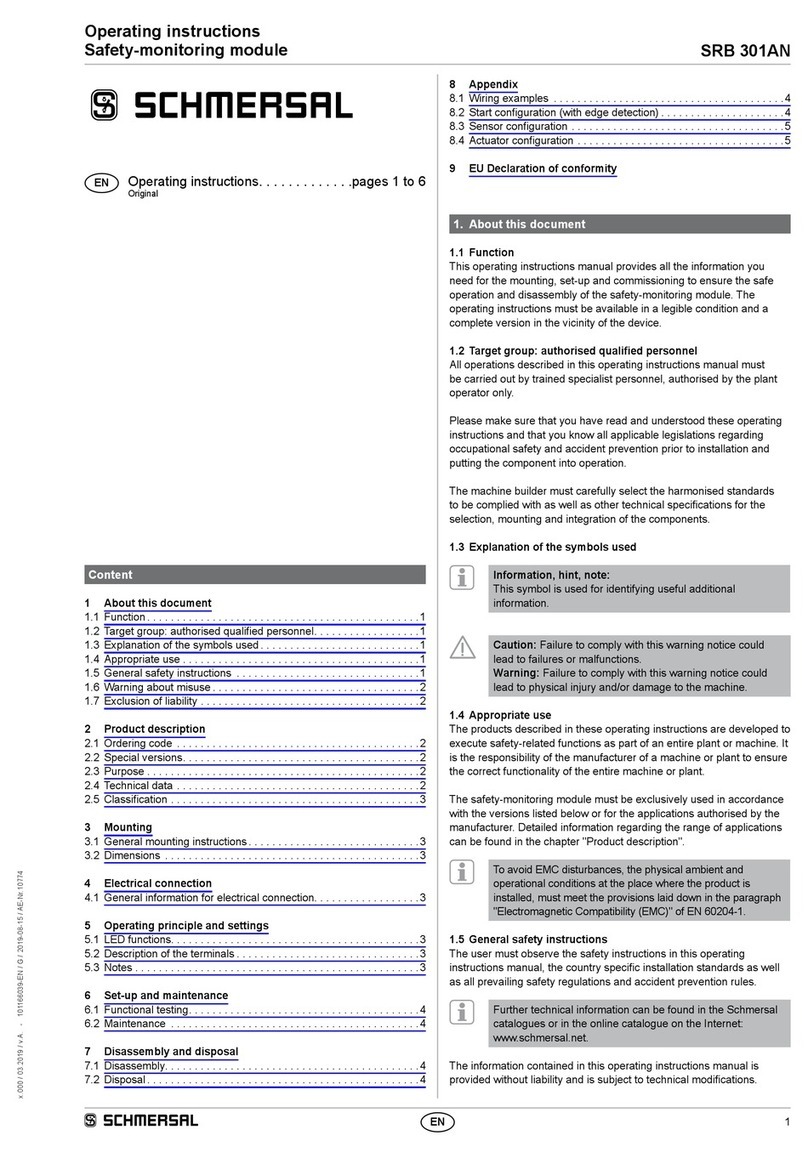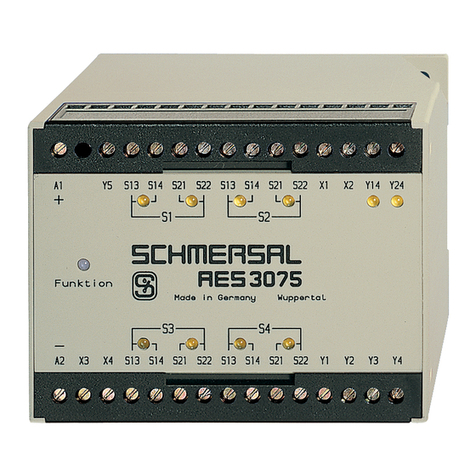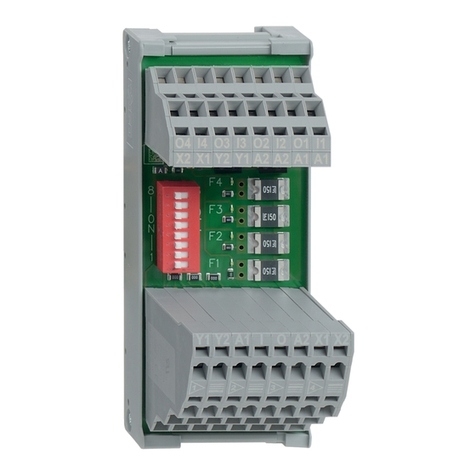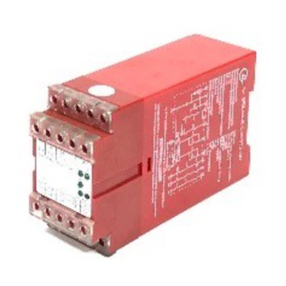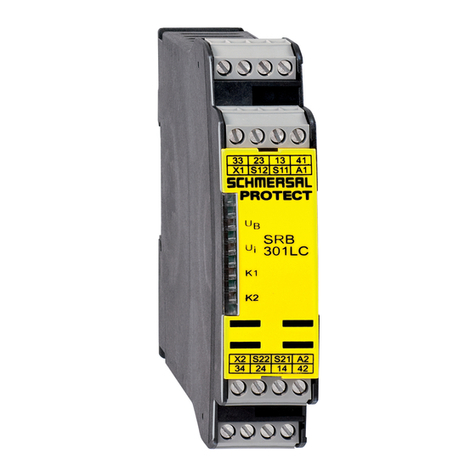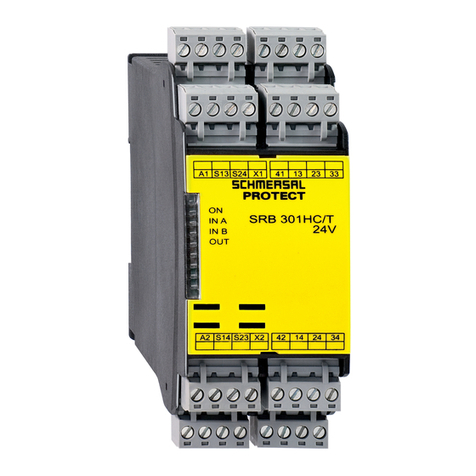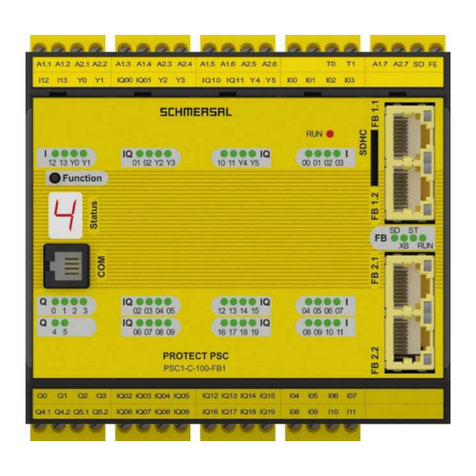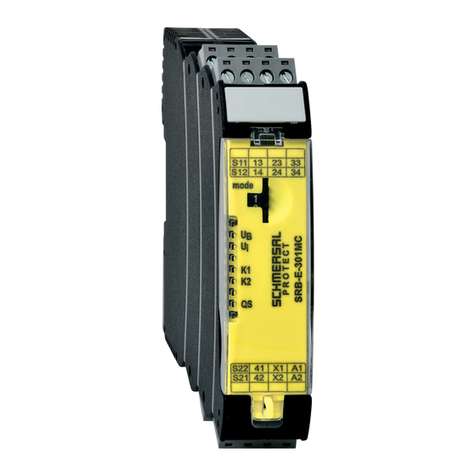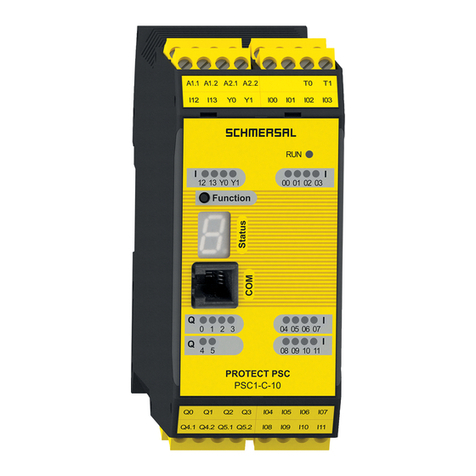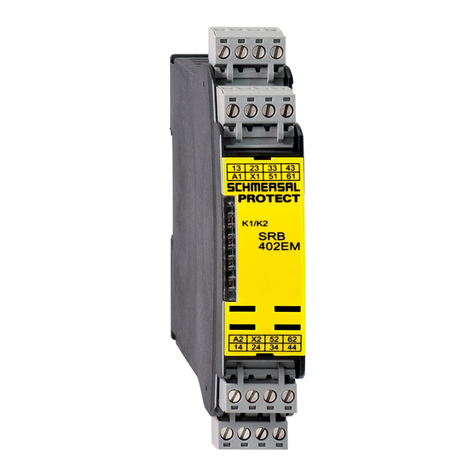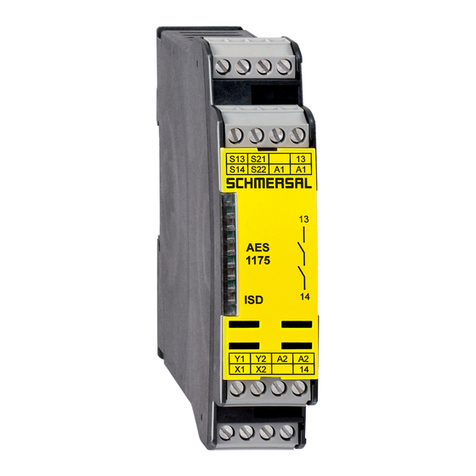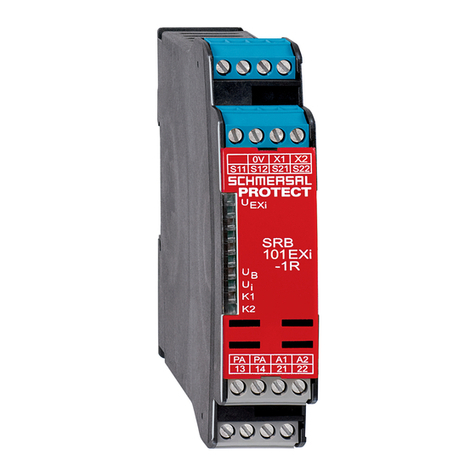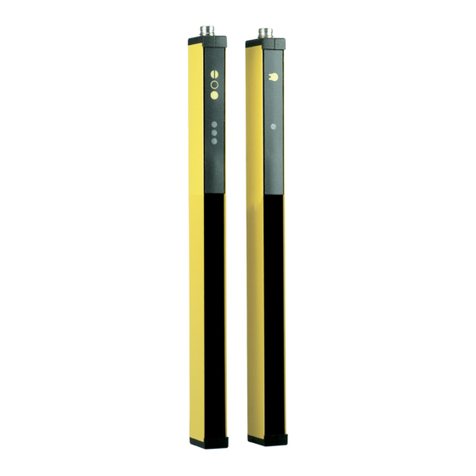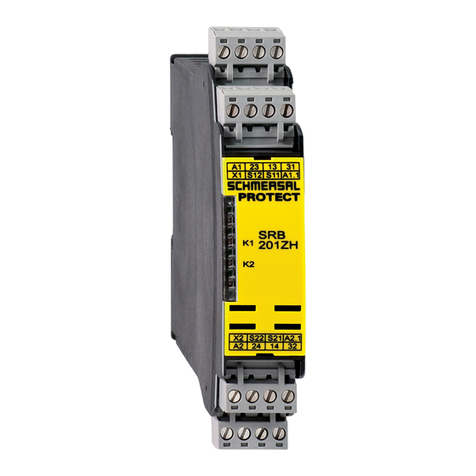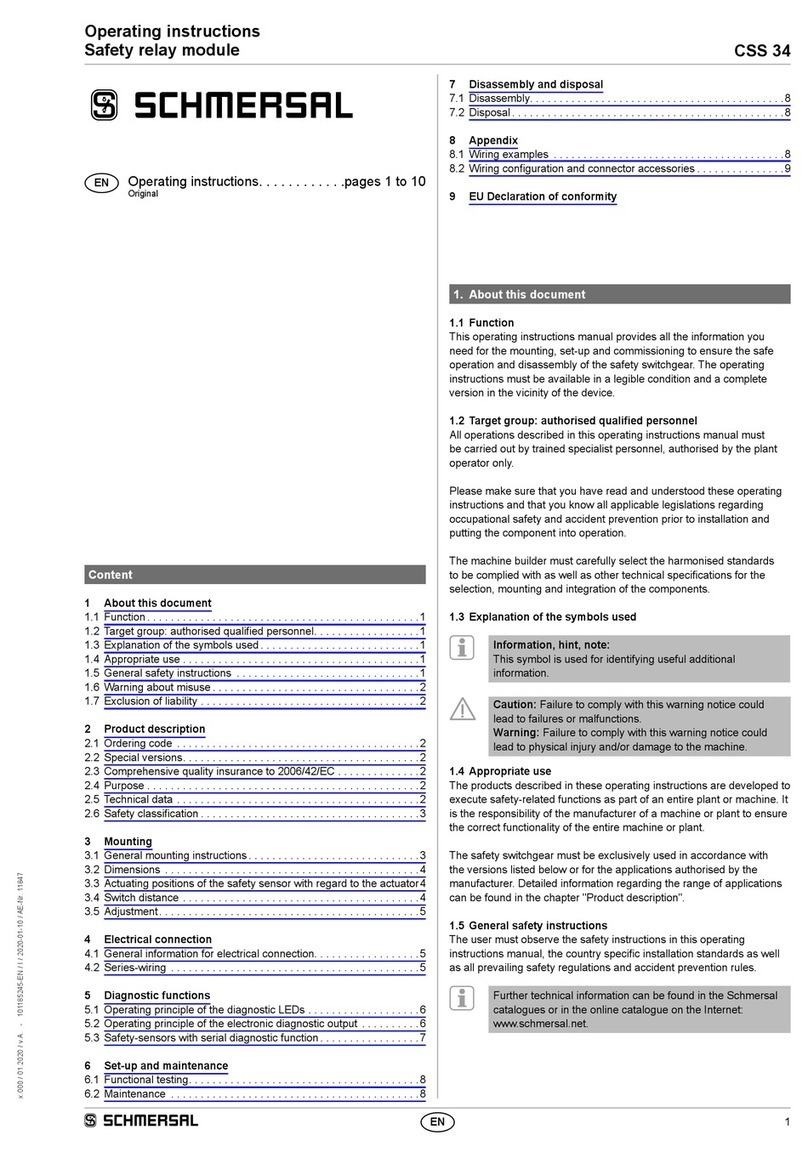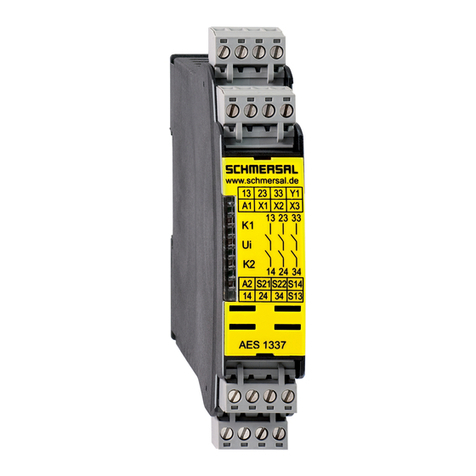
2
Operating instructions
Safety-monitoring module SRB 324ST V.3
EN
1.6 Warning about misuse
In case of inadequate or improper use or manipulations of
the safety-monitoring module, personal hazards or damage
to machinery or plant components cannot be excluded.
The relevant requirements of the standards ISO 14119 and
ISO 13850 must be observed.
1.7 Exclusion of liability
We shall accept no liability for damages and malfunctions resulting from
defective mounting or failure to comply with this operating instructions
manual. The manufacturer shall accept no liability for damages
resulting from the use of unauthorised spare parts or accessories.
For safety reasons, invasive work on the device as well as arbitrary
repairs, conversions and modifications to the device are strictly
forbidden; the manufacturer shall accept no liability for damages
resulting from such invasive work, arbitrary repairs, conversions and/or
modifications to the device.
The safety-monitoring module must only be used when the enclosure is
closed, i.e. with the front cover fitted.
2. Product description
2.1 Ordering code
This operating instructions manual applies to the following types:
SRB 324ST V.3
Only if the information described in this operating instructions
manual are realised correctly, the safety function and
therefore the compliance with the Machinery Directive is
maintained.
2.2 Special versions
For special versions, which are not listed in the order code below 2.1,
these specifications apply accordingly, provided that they correspond to
the standard version.
2.3 Purpose
The safety-monitoring modules for integration in safety circuits are
designed for fitting in control cabinets. They are used for the safe
evaluation of the signals of positive break position switches for safety
functions or magnetic safety sensors on sliding, hinged and removable
safety guards as well as emergency stop control devices and AOPDs
(safety light barriers).
The safety function is defined as the opening of the enabling
circuits13-14, 23-24 and 33-34 and the delayed opening of the enabling
circuits 47-48 and 57-58 when the inputs S11-S12 and/or S21-S22 are
opened. The safety-relevant current paths with the outputs contacts
13-14, 23-24 and 33-34 meet the following requirements under
observation of a PFH value assessment (also refer to chapter 2.5
"Safety classification"):
– Control category 4 – PL e to ISO 13849-1
– SIL 3 to IEC 61508-2
– corresponds to SILCL 3 to EN 62061
The safety-relevant current paths with the outputs contacts 47-48 and
57-58 meet the following requirements under observation of a PFH
value assessment (also refer to chapter 2.5 "Safety classification"):
– Control category 3 - PL d to ISO 13849-1
– SIL 2 to IEC 61508-2
– SILCL 2 to EN 62061
To determine the Performance Level (PL) to ISO 13849-1 of the entire
safety function (e.g. sensor, logic, actuator), an assessment of all
relevant components is required.
The entire concept of the control system, in which the safety
component is integrated, must be validated to the relevant
standards.
2.4 Technical data
General data:
Standards: EN 60204-1, IEC 60947-5-1,
ISO 13849-1, IEC 61508
Climate resistance: EN 60068-2-78
Mounting: snaps onto standard DIN rail to EN 60715
Terminal designations: IEC 60947-1
Material of the housings: Plastic, glass-fibre reinforced
thermoplastic, ventilated
Material of the contacts: AgSnO, AgNi, self-cleaning, positive drive
Weight: 420 g
Start conditions: Automatic or start button (monitored)
Feedback circuit available: yes
Pull-in delay for automatic start: typ. 250 ms
Pull-in delay with reset button: typ. 20 ms
Drop-out delay in case of emergency stop: typ. 30 ms / max. 36 ms
Drop-out delay on "supply failure": typ. 80 ms
Mechanical data:
Connection type: Screw connection
Cable sections: 0.25 … 2.5 mm²
Connecting cable: rigid or flexible
Tightening torque for the terminals: 0.6 Nm
With removable terminals: yes
Mechanical life: 10 million operations
Resistance to shock: 10 g / 11 ms
Resistance to vibration: 10 … 150 Hz, Amplitude 0.35 mm
Ambient temperature: –25 °C … +60 °C
Storage and transport temperature: –40 °C … +85 °C
Protection class: Enclosure: IP40
Terminals: IP20
Clearance: IP54
Air clearances and creepage distances to IEC 60664-1: 4 kV/2
(basic insulation)
EMC rating: to EMC Directive
Electrical data:
Contact resistance in new state: max. 100 mΩ
Power consumption: max. 3.2 W / 7.1 VA,
plus signalling outputs
Rated operating voltage Ue:24 VDC: –15% / +20%,
residual ripple max. 10%,
24 VAC: –15% / +10%
Frequency range: 50 / 60 Hz
Fuse rating for the operating voltage: Internal electronic trip,
tripping current F1: > 2.5 A,
tripping current F2: > 50 mA (S11-S31) /
> 800 mA (X4)
Current and voltage at the control circuits:
- S11, S12, S21, S22, S31, S32: 24 VDC, 10 mA
- X1, X2: 24 VDC, start impulse, 350 mA / 15 ms
- X3, X4: 24 VDC, start impulse, 130 mA / 80 ms
- X4, X5: 24 VDC, start impulse 140 mA / 15 ms
Monitored inputs:
Cross-wire detection: optional
Wire breakage detection: yes
Earth connection detection: yes
Number of NO contacts: 0
Number of NC contacts: 2
Cable length: 850 m with 1.5 mm²,
1,400 m with 2.5 mm²
Conduction resistance: max. 40 Ω
Outputs:
Number of safety contacts: 5
Number of auxiliary contacts: 1
Number of signalling outputs: 3
